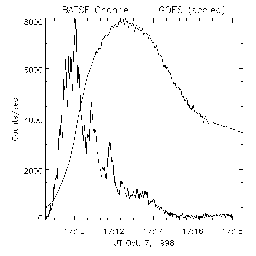
Recent visitors to ISAS have questioned the reality of what we call the "Neupert Effect", after GSFC solar physicist Werner Neupert. This week we illustrate this effect by looking at the light curves of the most recent major flare observed by Yohkoh:

This shows the soft X-ray light curve of the flare (from the GOES soft channel), together with the hard X-ray light curve from CGRO/BATSE. The BATSE "channel 1" counts (nominally 25-50 keV) are roughly equivalent to the Yohkoh HXT M2 channel (nominally 33-53 keV). The GOES light curve is normalized arbitrarily to BATSE. The Neupert effect simply notes that the hard X-rays occur during the rise phase of the soft X-rays. This general pattern is what one would expect if the hard X-ray flux somehow accompanied the energy release phase in the flare, when the hot plasma is building up in the coronal loops that we observe (for example) with Yohkoh SXT:

This flare, unfortunately, appears to have been too compact and/or in the wrong geometry to show impulsive behavior in the soft X-ray footpoints. We make the following points about the nature of the Neupert effect:
Almost any flare model essentially predicts this kind of behavior, so its occurrence does not make any statement regarding mechanisms such as magnetic reconnection, shock waves, mysterious kinds of turbulent motions, or the like. However as pointed out in the third bullet above, there is a distinct need for more theoretical work. This is all the more relevant now that SOHO/MDI has made the revolutionary discovery of sunquakes, predicted by the thick-target theory and fully consistent with the Neupert effect - but without complete theoretical work yet. If you are interested in more detail, I have written a lightweight review paper of the Yohkoh contributions to our observational understanding the Neupert Effect for the Yohkoh seventh anniversary symposium, to be published (mostly in Japanese) by ISAS. There is also a somewhat cleaner PostScript version of the paper, "Yohkoh and non-thermality in flares". In spite of the simplicity and reasonableness of the picture presented by the Neupert Effect, there are many interesting and important physical questions that are not resolved yet. These are at the core of the flare process, because the "impulsive phase" of a flare marks the time of strongest energy release.
Oct. 16, 1998: H. S. Hudson (email hudson@isass0.solar.isas.ac.jp)